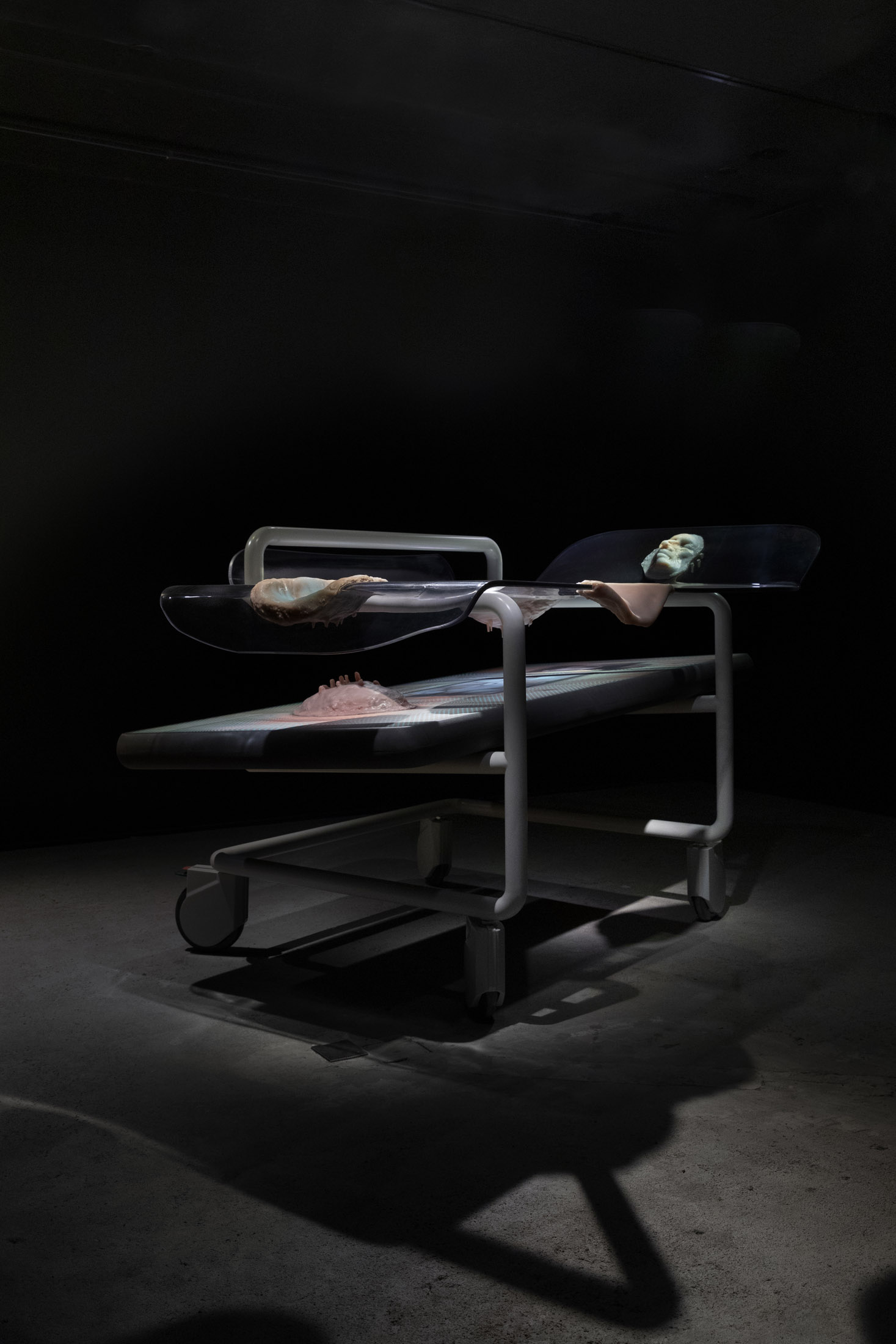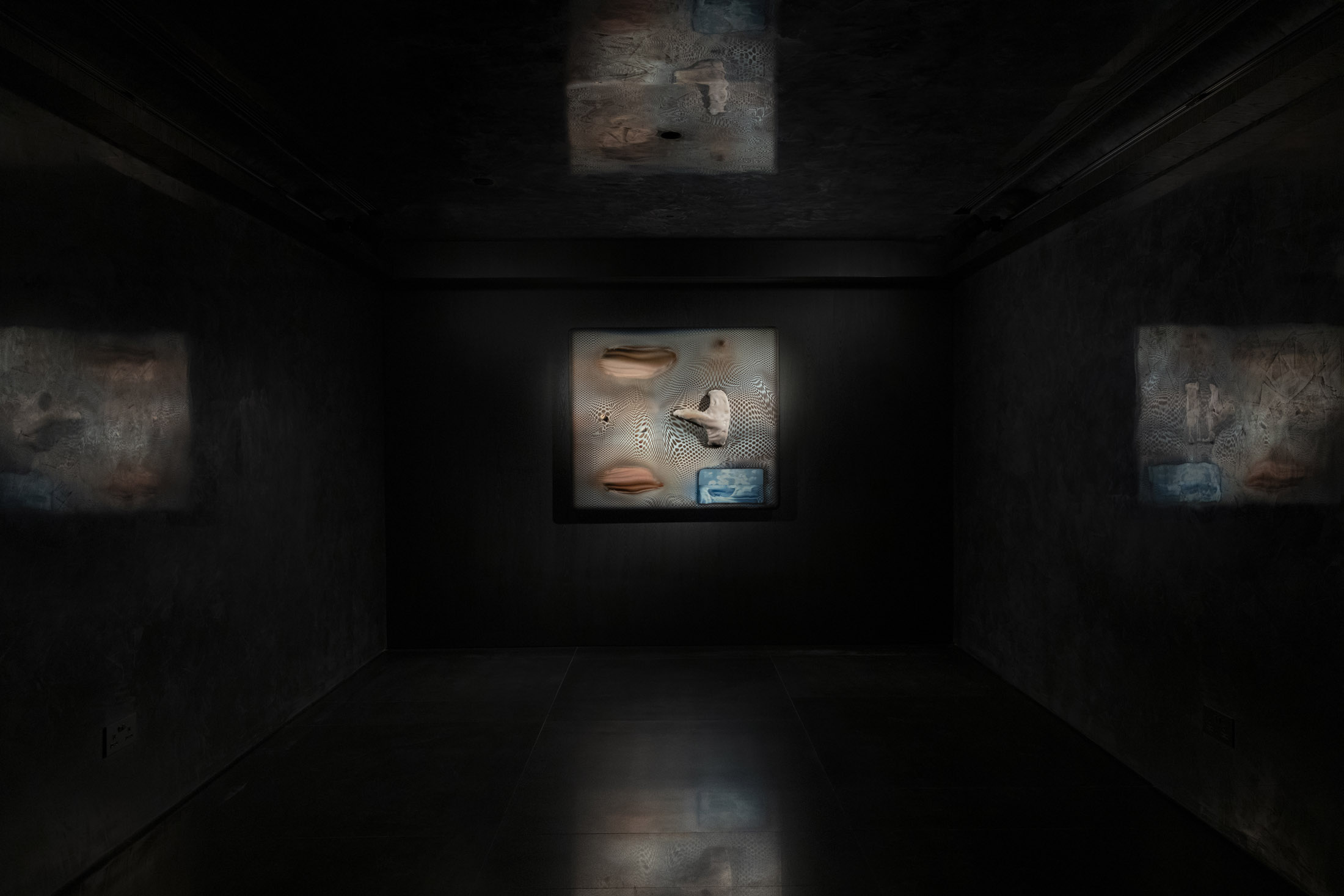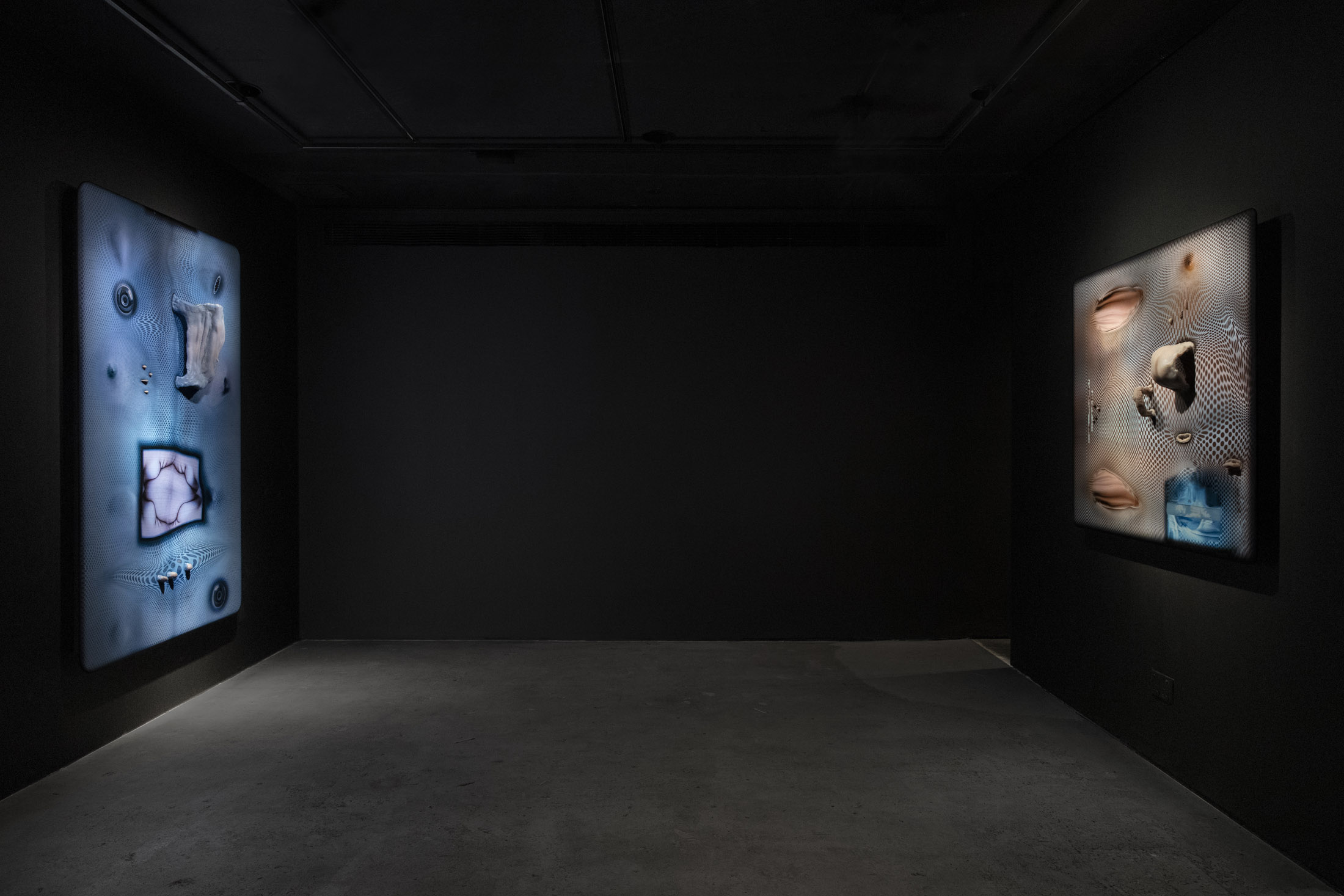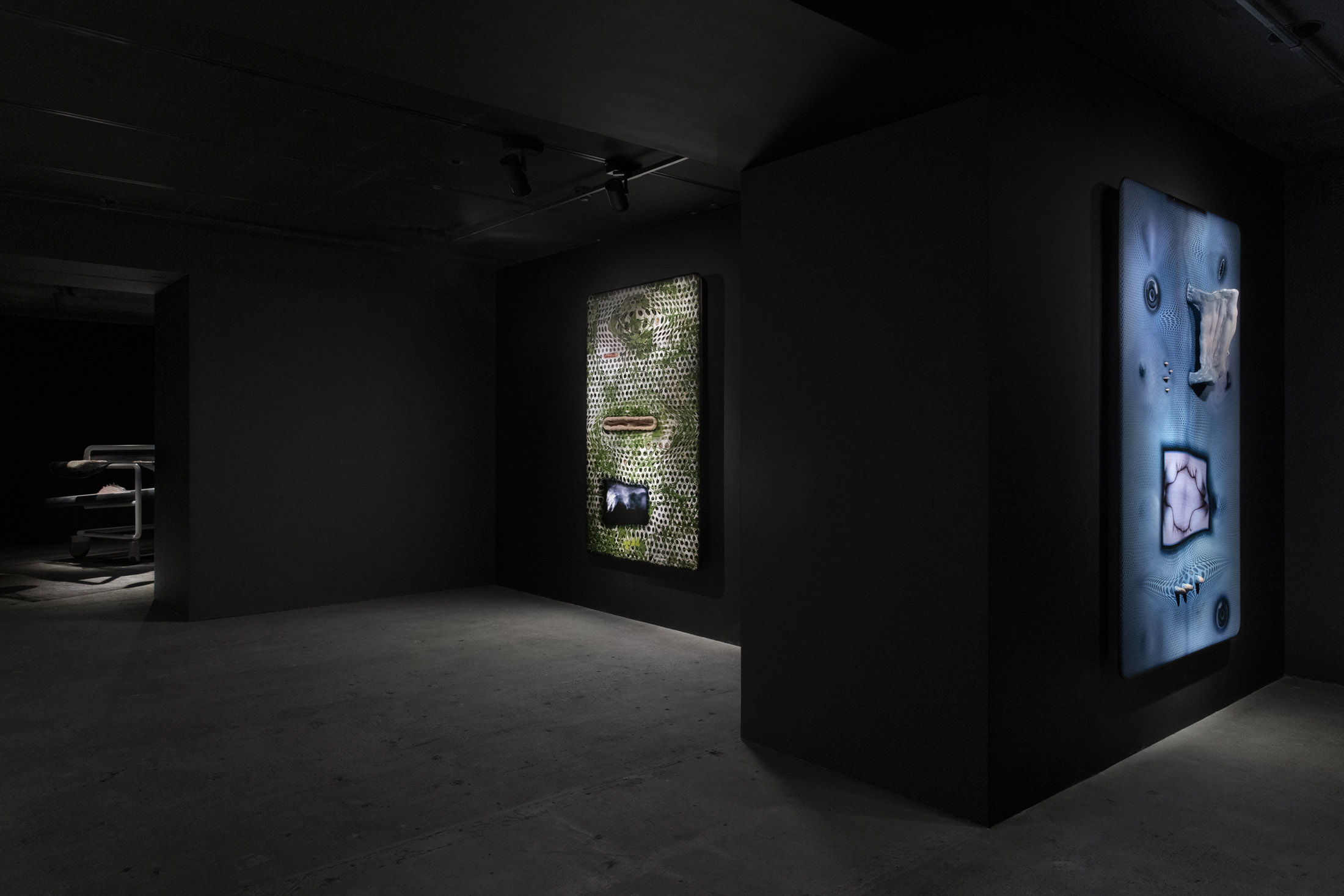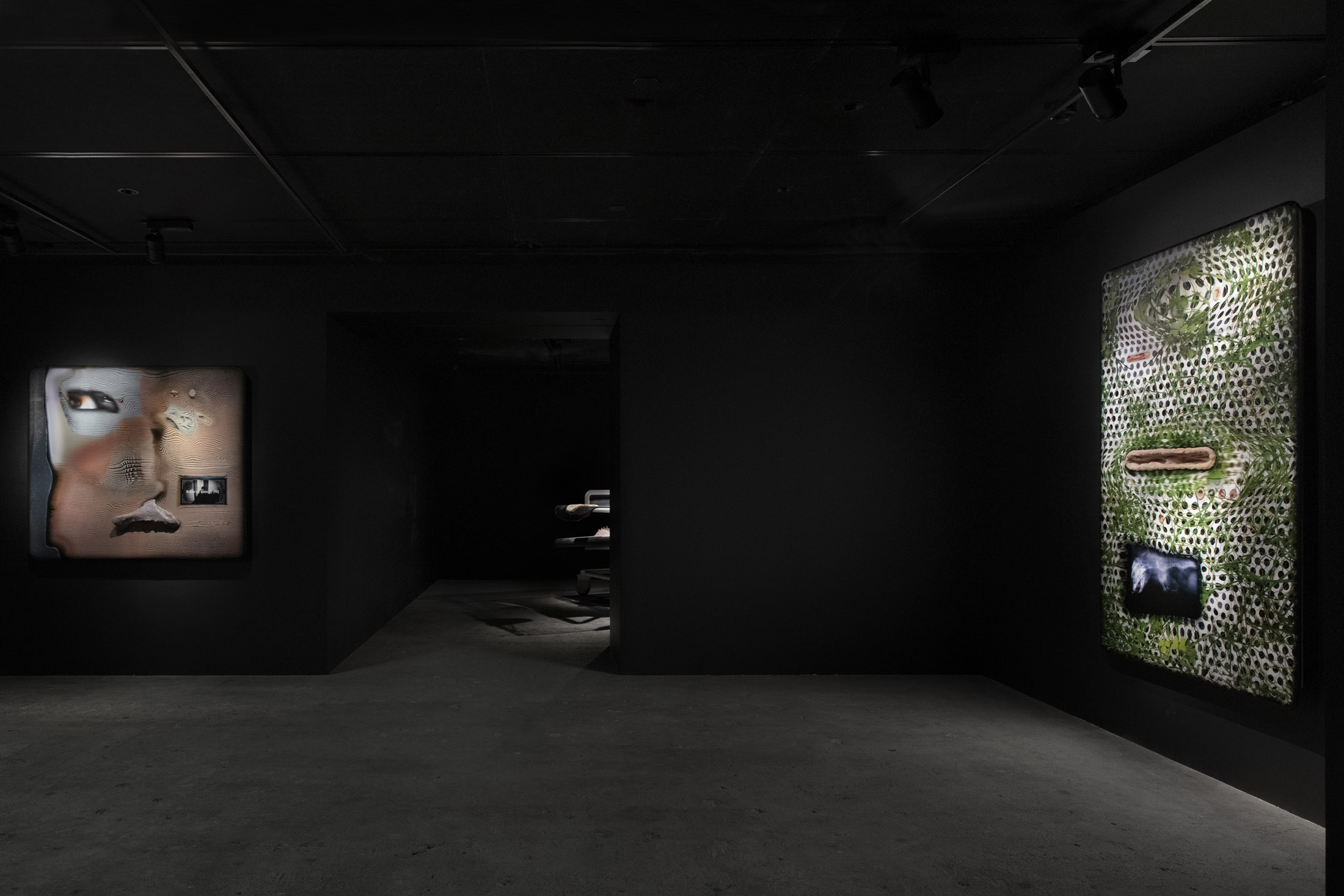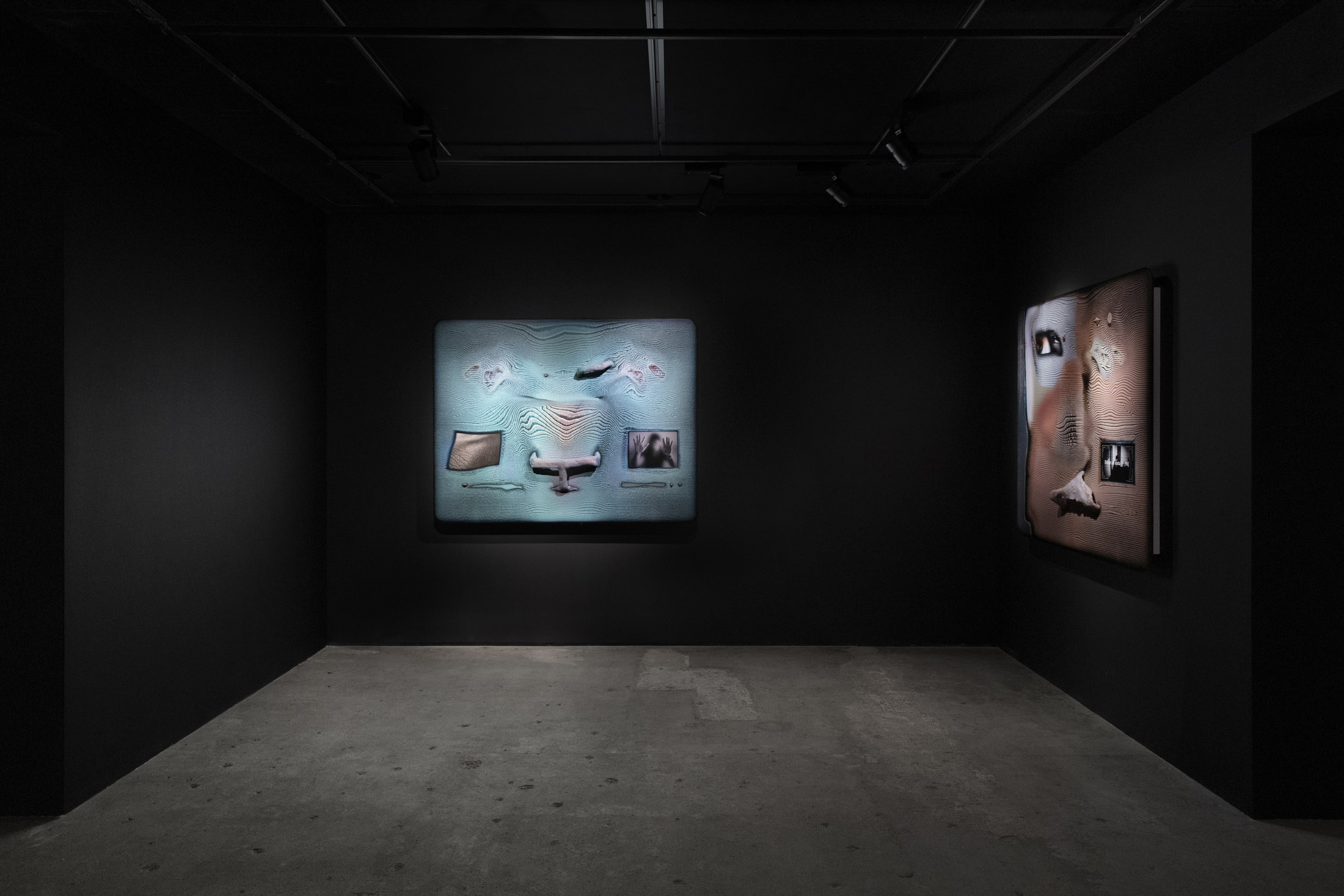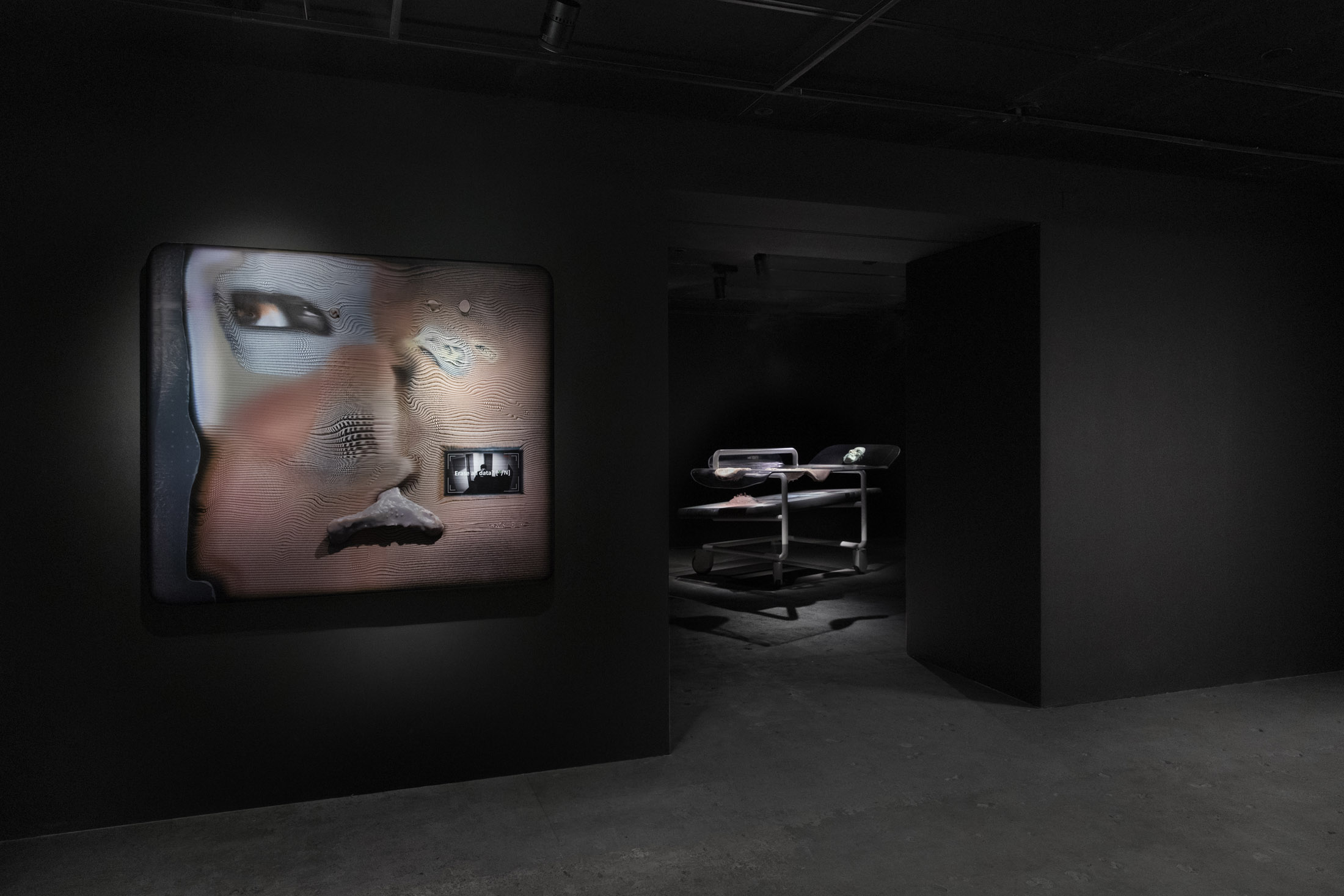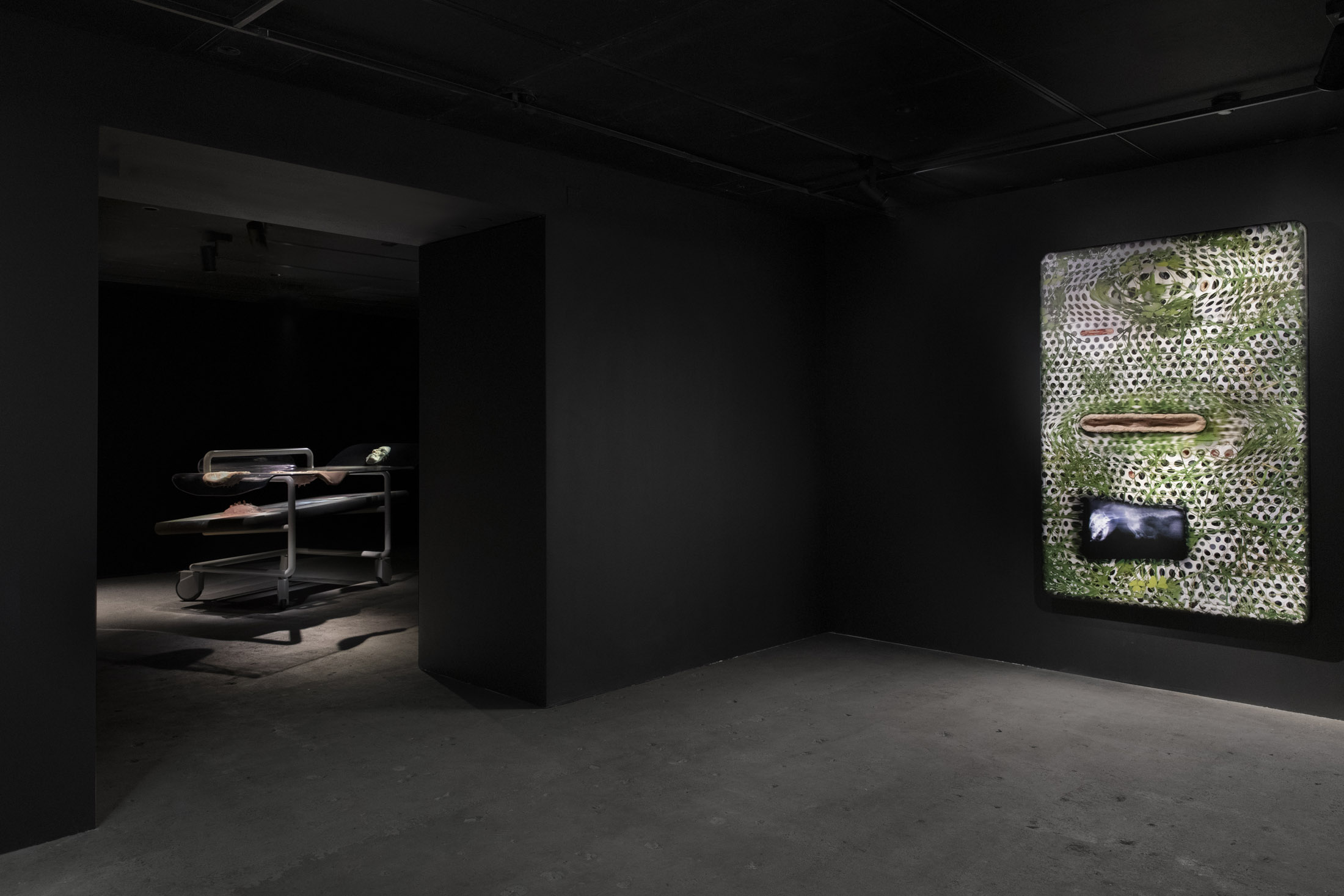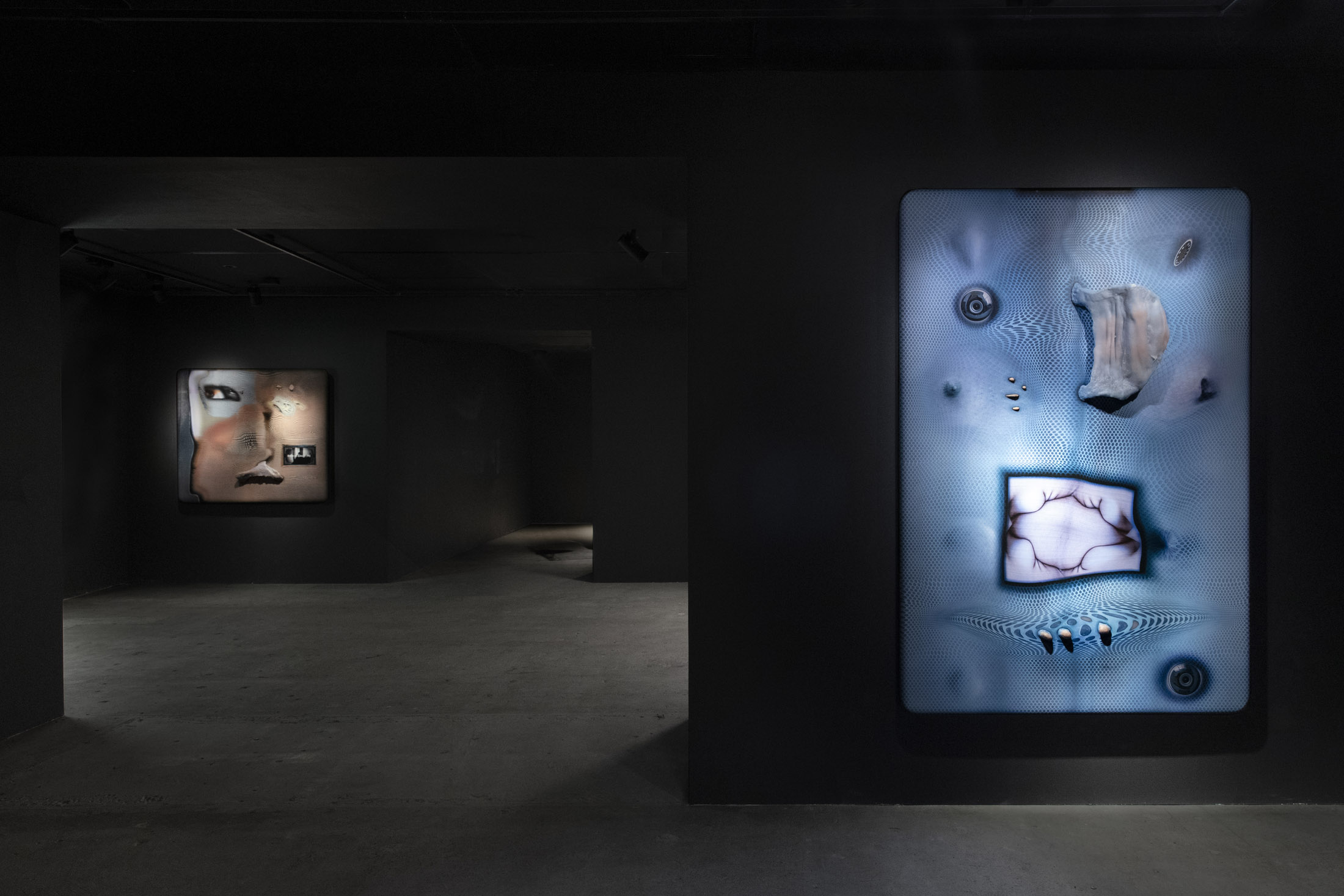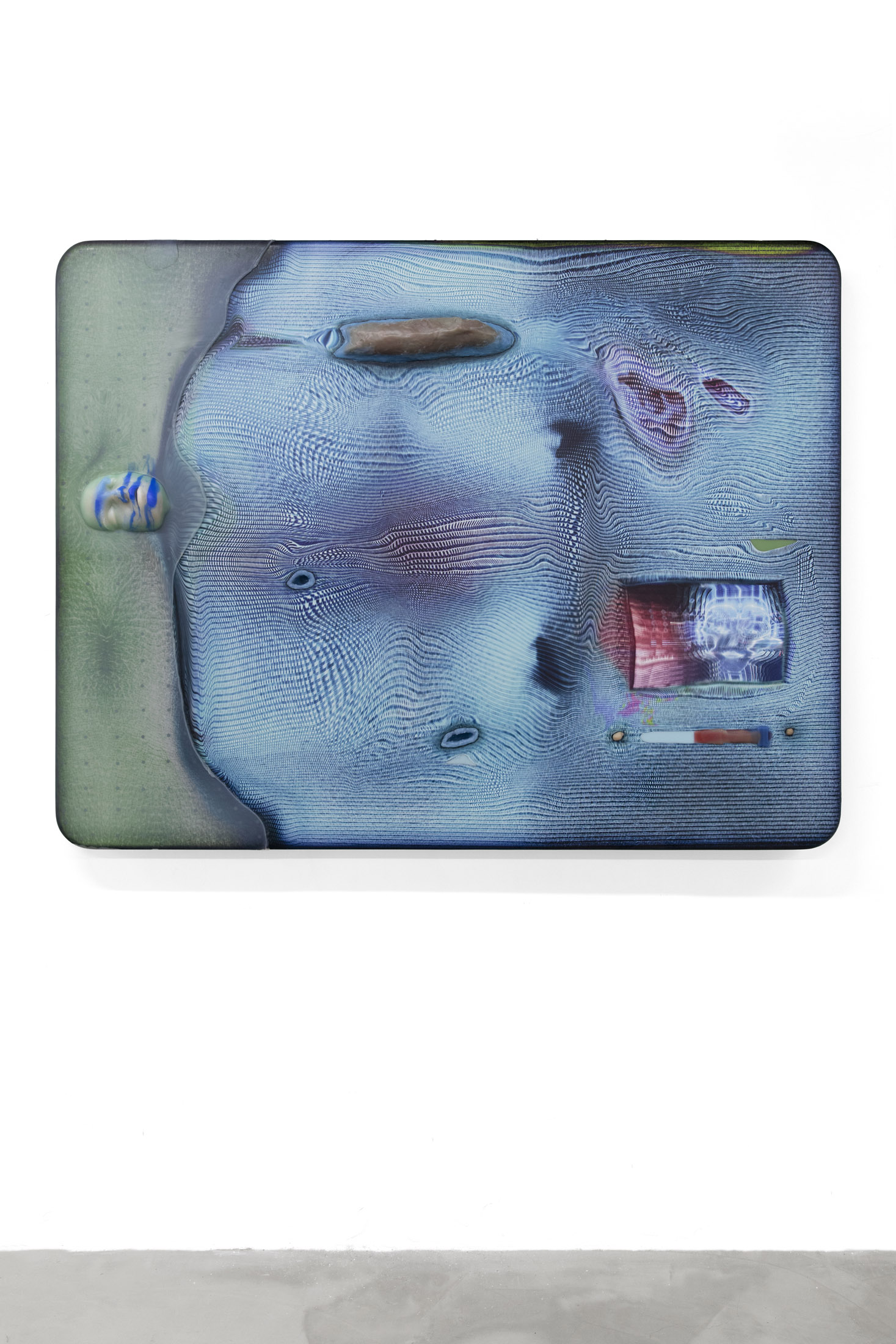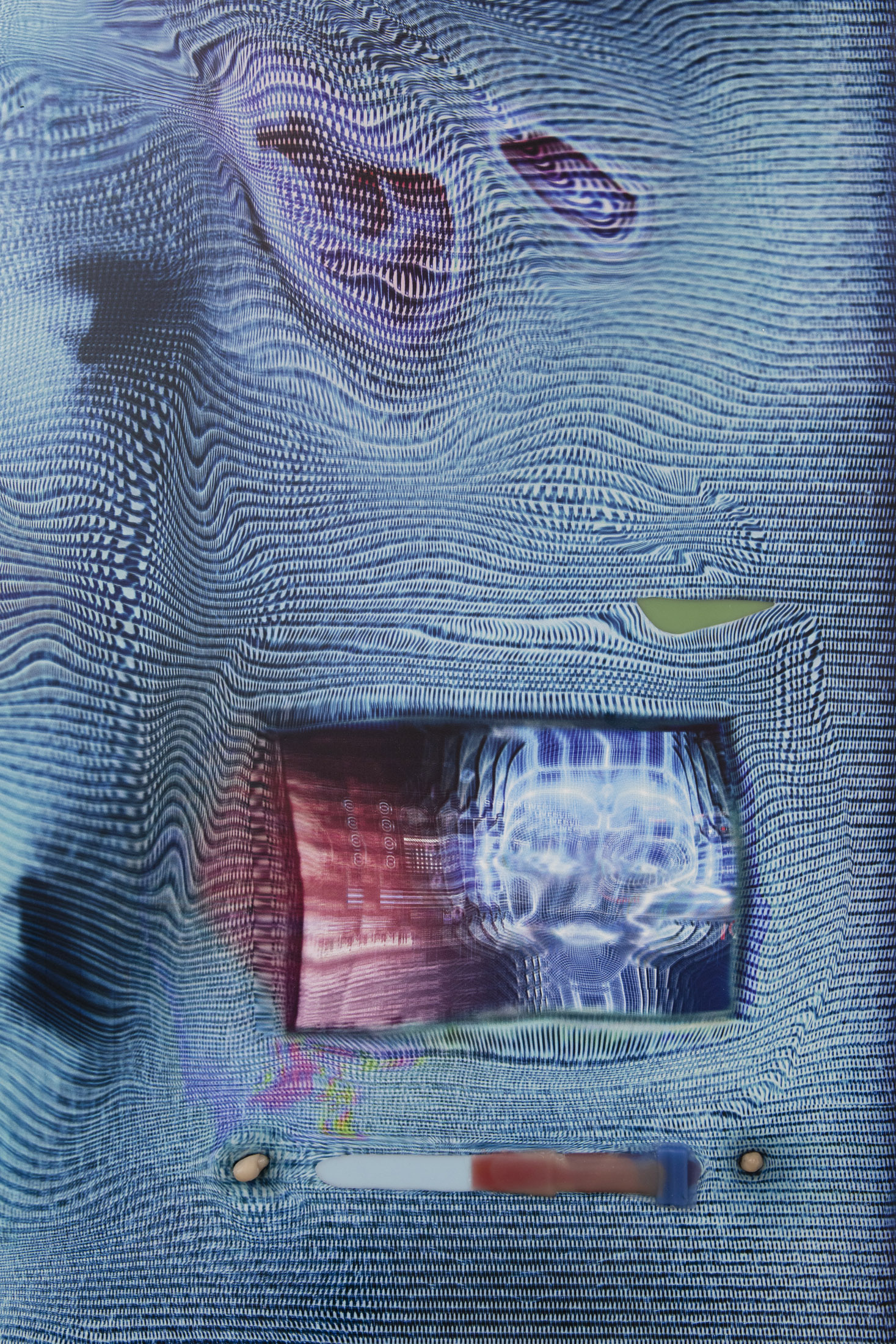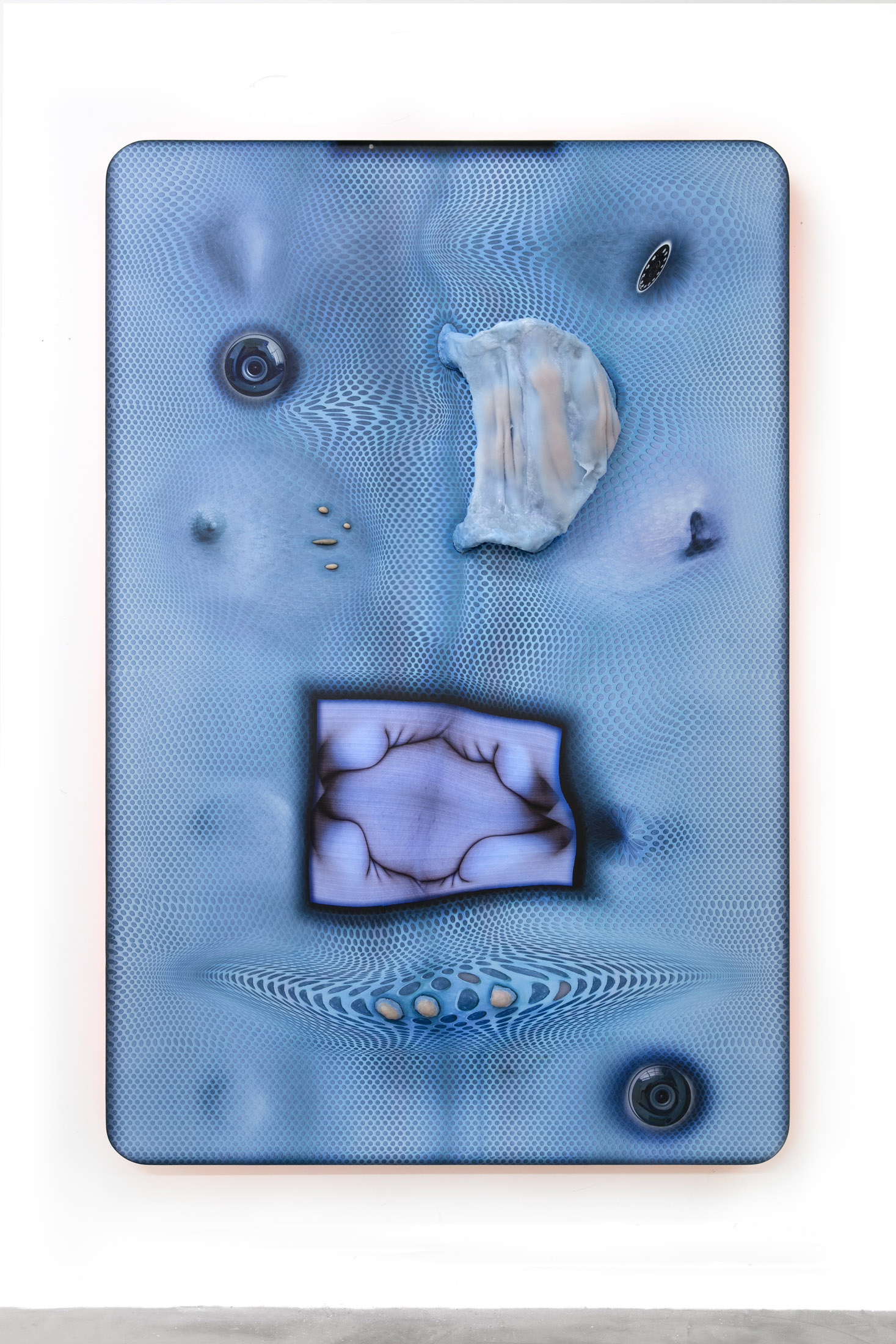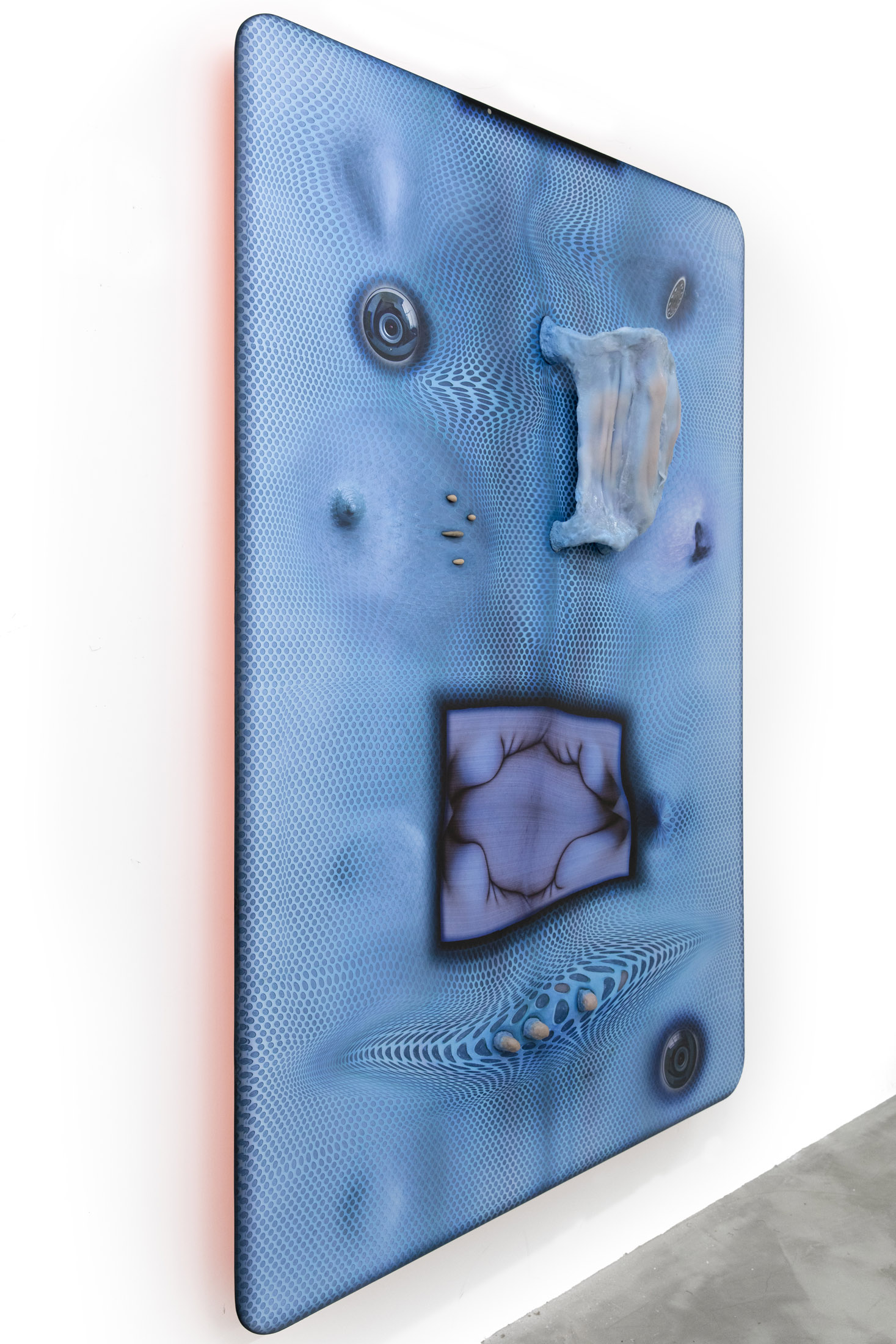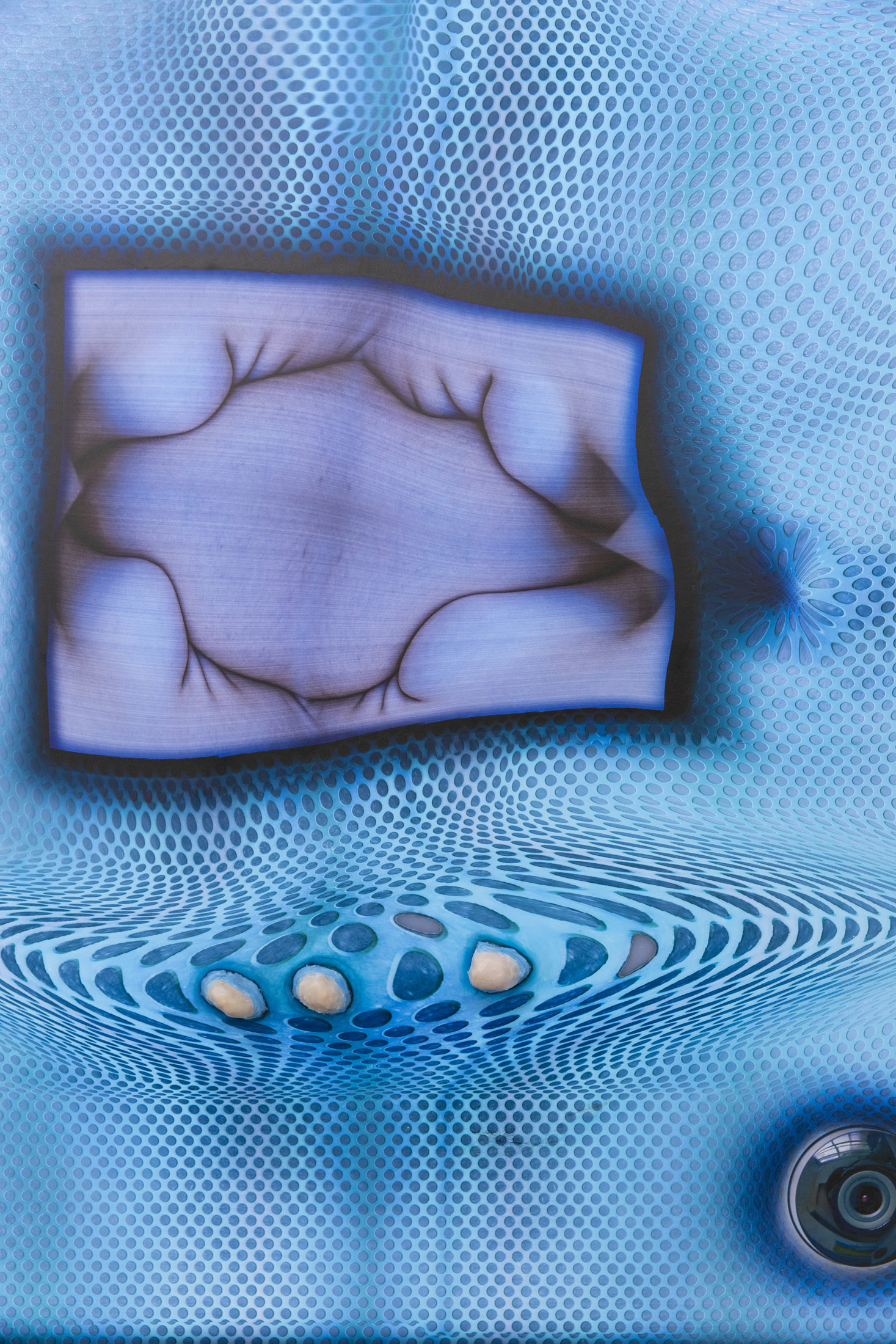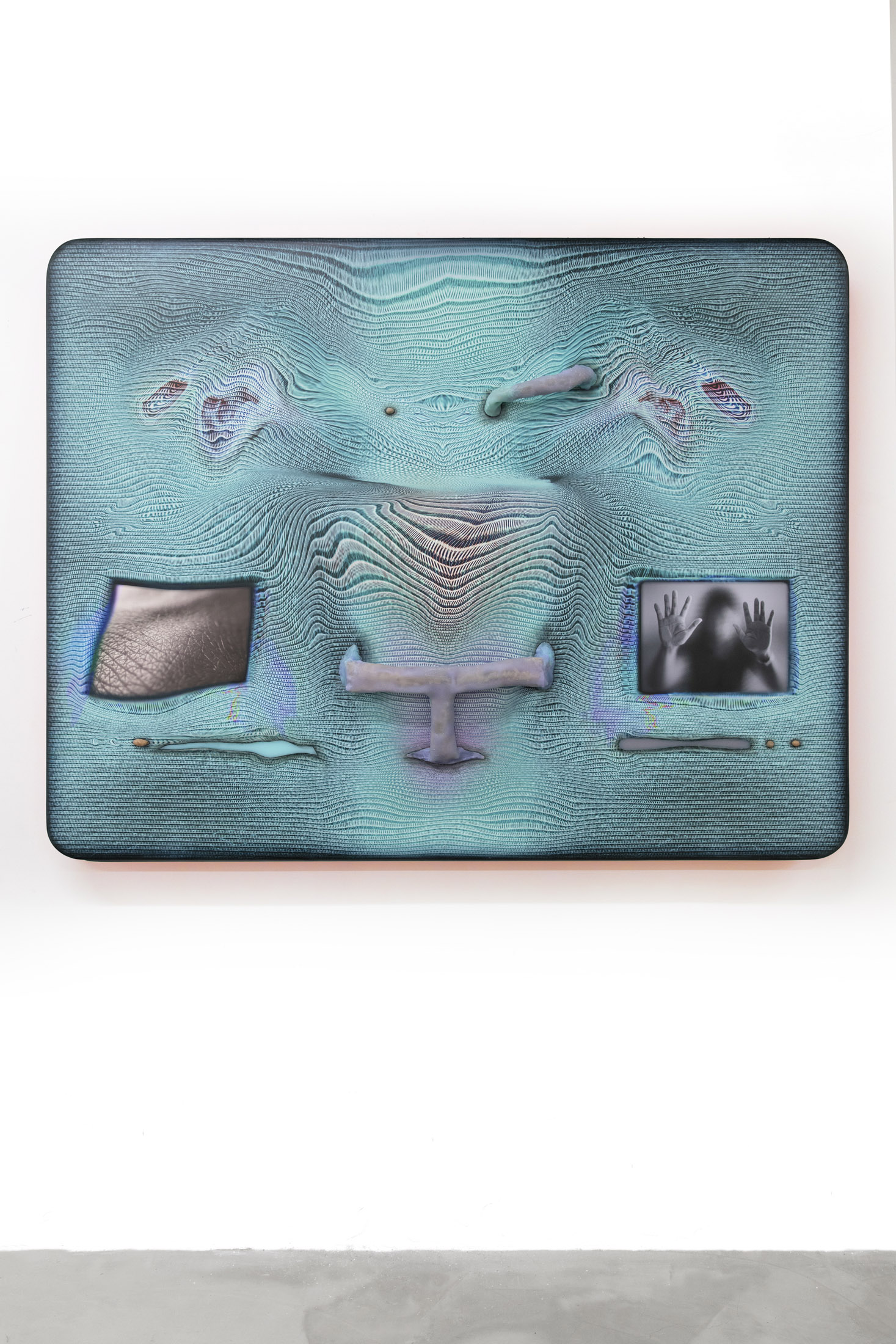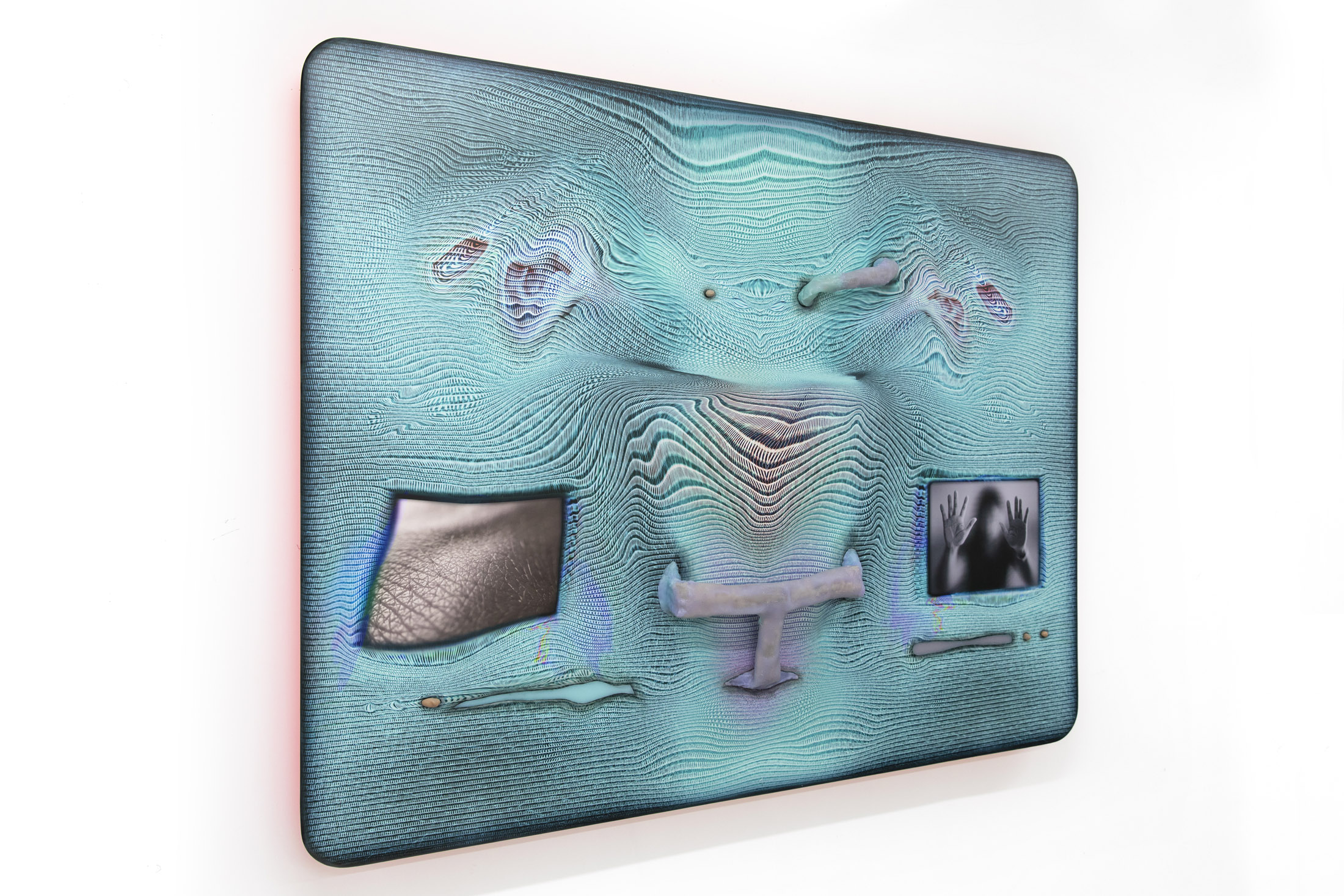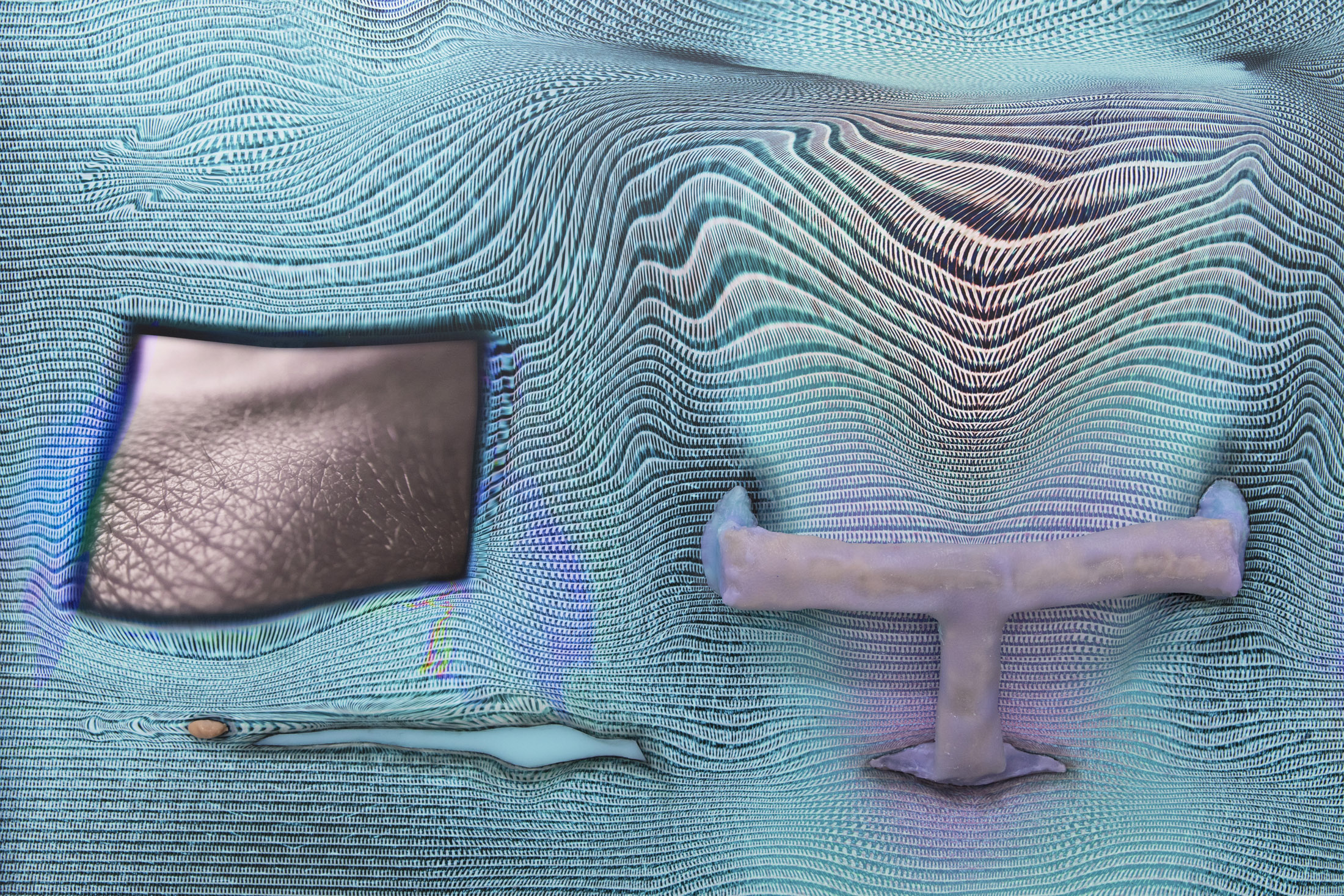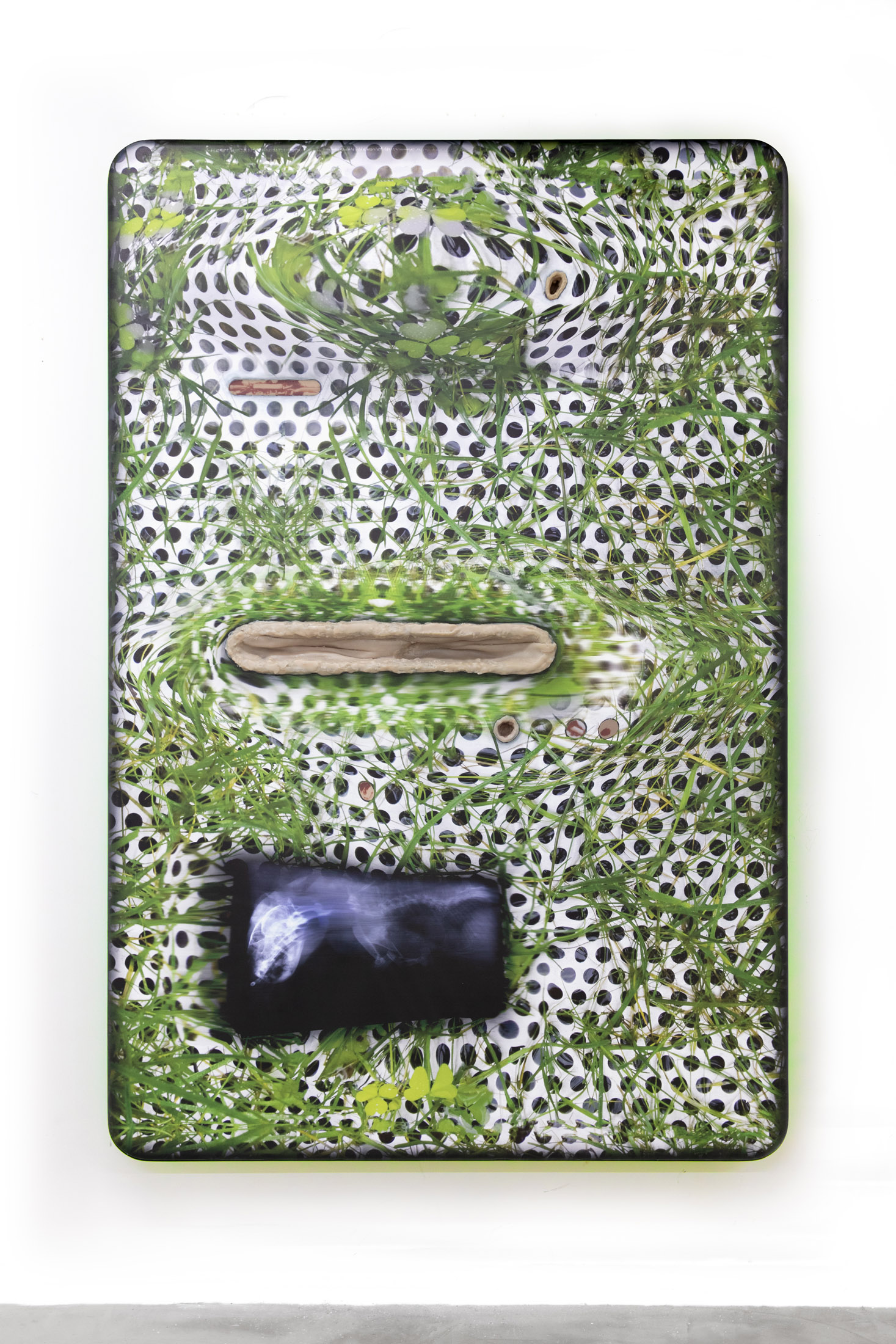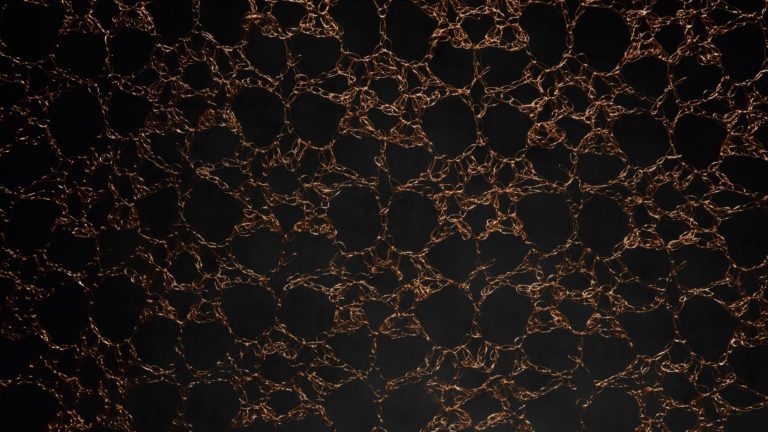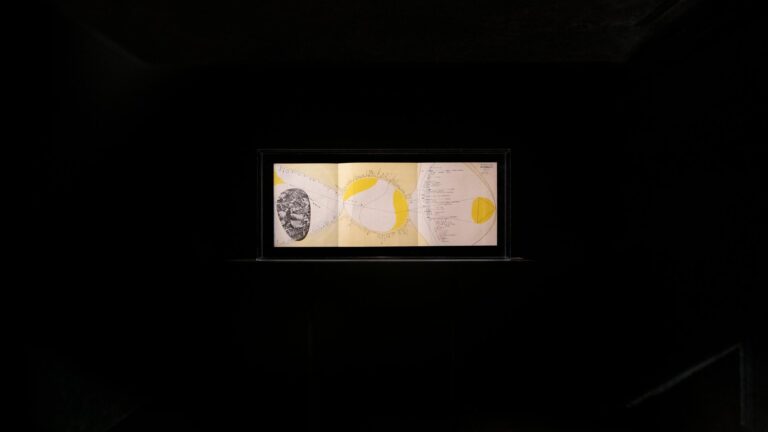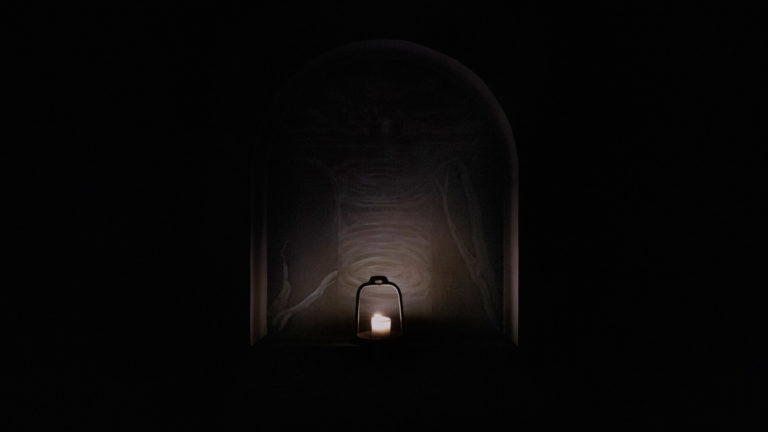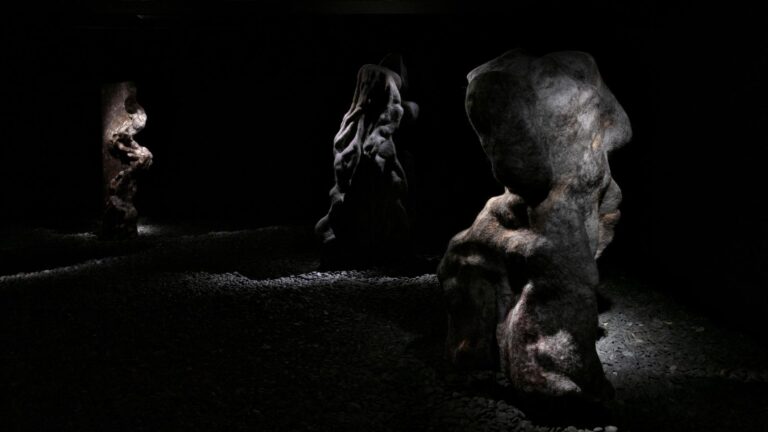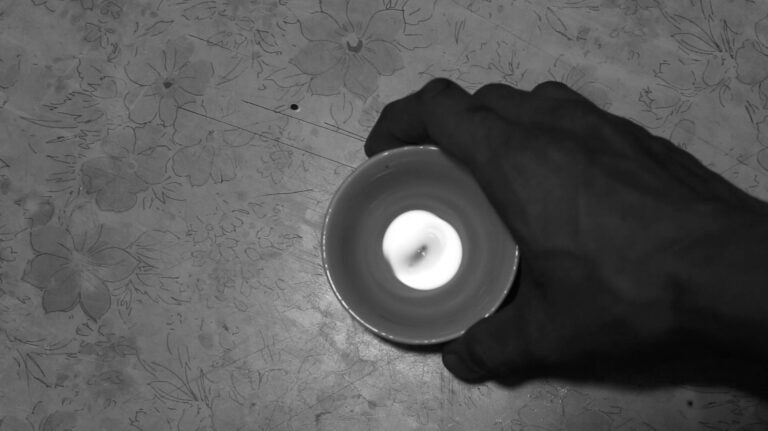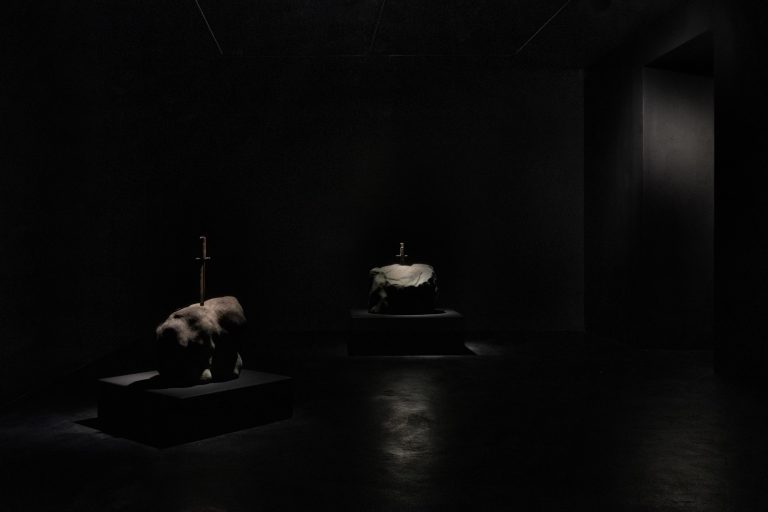Artist: Tishan Hsu
Exhibition title: screen-skins
Venue: Empty Gallery, Tin Wan, Hong Kong
Date: March 18 – June 24, 2023
Photography: Michael Yu / all images copyright and courtesy of the artist and Empty Gallery
Empty Gallery is pleased to present screen-skins, New York-based artist Tishan Hsu’s second solo exhibition with the gallery. Since the 1980s, Hsu’s practice has investigated the complex manner in which information technology has altered the affective, perceptual, and political contours of our embodied experience. Continually refining his practice to keep pace with these emergent phenomena, Hsu works between painting and sculpture, employing methods such as UV printing, casting, and digital photo manipulation to create objects which are poised at the limit between the physical and the virtual. screen-skins extends a mode of practice first articulated in delete and subsequently refined in presentations at the 59th Venice Biennale and Miguel Abreu Gallery, broadening Hsu’s scope of inquiry to encompass the expanded sphere of biopolitics and the digital surveillance state.
Comprising six new paintings and a monumental sculpture installed on the 19th floor gallery, the high definition surfaces of the works in screen-skins pulsate with a quiet menace. Pieces such as camera-screen-skin and double-breath 1 are defined by an all-over opticality which was first articulated as oscillating scanlines in Hsu’s 1980s work–– where they denoted a sort of hypnotic or dazed absorption in the illusionistic space of the screen–– but has gradually morphed into omnipresent patterns of dots or meshes. These warped topographies express the feeling of a capitulation to or engulfment by a network which is nearly psychedelic in its sense of power and scale. Imbricated within these patterns are elements of representational imagery–– fragments of body parts, fleshy folds and mysterious orifices–– which in their very anonymity seem to speak to the reduction of the individual subject into abstract units of quantifiable and controllable data. Both emerging from these surfaces and burrowing into, or seeping out of them, are pools of undifferentiated corporeal matter rendered in pigmented silicone. These anatomical eruptions speak to the stubborn persistence of the material body in an era in which it has begun to seem increasingly obsolete. As a whole, these works explore the neuro-biological enmeshment of the contemporary subject within a network which is at once everywhere and nowhere, invisible and yet palpable. They articulate a sort of mundane dystopia, one in which consumption and pleasure–– indeed, the ground of experience itself–– are inextricably tied to surveillance, the policing of bodies, and more subtle forms of biopolitical control. In this concern with the monitoring and control of bodies, they seem to hearken back to Hsu’s work at the end of the 80s, in which the meeting of technological and bureaucratic systems was explicitly articulated for the first time.
Occupying a position of singular importance within the exhibition, phone-breath-bed 3 is the third in a series of sculptures which Hsu began in 2021. A hybrid construction which combines hospital bed, personal computing device, and life support system, it is perhaps Hsu’s most somber exploration of the juncture between devices and bodies. Consisting of a rolling steel armature which cradles both a transparent polycarbonate body punctuated by silicone casts and a touch-screen like printed surface, the work reveals the deeper logics linking the utilitarian concerns of the medical industry to the optimized interfaces of modern UI/UX design. With its exposed cavities and it’s death-mask like visage, phone-breath-bed 3 summons up the liminal space where the dissociative effects of corporeal trauma and bodily decline fold into and reinforce the absorptive world of the screen–– the uncomfortable intersection between the morgue and the datacenter.
During a historical moment–– the 1980s–– when many of his artistic peers were still hurriedly playing catch up to the implications of older regimes of image circulation, Hsu’s singular focus on the consequences of the then-nascent digital sphere–– not as simple fetishism of so-called new media but considered in all of it’s manifold implications for the shifting nature of human experience–– has been aptly described as prescient. His practice represents an ongoing and perhaps, perpetually unfinished attempt to understand and map out the ontology of current experience. Hsu does this not, however, through the studied artifice of the analyst or the fabricated omniscience of the cultural theorist, but through a kind of immanent grasping amidst the flow of bodies and fluids, screens and data. screen-skins reconfigures this line of inquiry to resonate with a contemporaneity in which the impulse towards technological optimism is at its lowest ebb. In this state of affairs, the submerged authoritarian aspects of the electronic state are on full display, but the subject is far too enmeshed, both cognitively and physically, to see an alternative. The passage of time thus becomes marked by an oscillation between the seductive fluidity of networked screens and the unwanted consciousness of a corporeal shell which stubbornly continues to exist beyond the point of its own obsolescence. Hsu’s practice, perhaps more than that of any other living artist, seems to articulate this precarious and paradoxical status of the object–– and perhaps, even matter itself–– when confronted with its own participation in a regime of negative virtuality emerging from a Hobbesian cybernetics.
Tishan Hsu (b. Boston, Massachusetts), his early years were in Zurich, Switzerland, and Ohio, Wisconsin, Virginia and New York, U.S. Hsu had his first one-person show as a teenager in Roanoke, Virginia, where his paintings were exhibited in museums throughout the region. He received his B.S.A.D in 1973 and M.Arch in 1975 from Massachusetts Institute of Technology. While at MIT, he also studied film and photography at the Carpenter Center, Harvard University. Hsu has resided in New York since 1979. Hsu first showed in New York at the Pat Hearn Gallery. Since 1985, Hsu has shown extensively in the US, Europe, Mexico and Asia, with works in many public and private collections. From 1988-90, Hsu lived and worked in Cologne, Germany and from 2014-16 in Shanghai, China.
Much of the artist’s work has attempted to convey the changing cognitive and physical effects of an embodied technology. Hsu’s interest in technology has not been in the use of a particular apparatus but the perception of a technological affect. His work has included drawings, paintings, interactive digital media projections, and sculpture.
Selected public and private collections include Metropolitan Museum, New York; Centre Pompidou, Paris; Museum fur Moderne Kunst (MMK), Frankfurt am Main; High Museum, Atlanta; Terra Museum, Mexico City; Los Angeles Museum of Contemporary Art, Los Angeles; Museum of Contemporary Art, North Miami; The Rubell Family Collection, Miami; Weisman Museum, Minneapolis; and The Whitney Museum of American Art, New York. Hsu has served as a Member of the Board of White Columns and a Governor for the Skowhegan School of Painting and Sculpture. He was a Professor of Sculpture at Sarah Lawrence College and a visiting professor at Pratt Institute and Harvard University. Tishan Hsu: Liquid Circuit (2020-21), his first survey exhibition covering the period 1982 to 2002, was curated by Sohrab Mohebbi, and held at SculptureCenter, New York, following its first iteration at the Hammer Museum, Los Angeles. His work is currently included in the 58th Carnegie International, organized by Sohrab Mohebbi, as well as the 58th International Art Exhibition, Venice Biennale: “The Milk of Dreams”, curated by Cecilia Alemani at Arsenale. He also participated in the 13th Gwangju Biennale, “Minds Rising, Spirits Tuning,” in 2021.
Installation view, Tishan Hsu: screen-skins, Empty Gallery; Hong Kong, March 18 – June 24, 2023. Photo: Michael Yu. Courtesy of the artist and Empty Gallery
Installation view, Tishan Hsu: screen-skins, Empty Gallery; Hong Kong, March 18 – June 24, 2023. Photo: Michael Yu. Courtesy of the artist and Empty Gallery
Installation view, Tishan Hsu: screen-skins, Empty Gallery; Hong Kong, March 18 – June 24, 2023. Photo: Michael Yu. Courtesy of the artist and Empty Gallery
Installation view, Tishan Hsu: screen-skins, Empty Gallery; Hong Kong, March 18 – June 24, 2023. Photo: Michael Yu. Courtesy of the artist and Empty Gallery
Installation view, Tishan Hsu: screen-skins, Empty Gallery; Hong Kong, March 18 – June 24, 2023. Photo: Michael Yu. Courtesy of the artist and Empty Gallery
Installation view, Tishan Hsu: screen-skins, Empty Gallery; Hong Kong, March 18 – June 24, 2023. Photo: Michael Yu. Courtesy of the artist and Empty Gallery
Installation view, Tishan Hsu: screen-skins, Empty Gallery; Hong Kong, March 18 – June 24, 2023. Photo: Michael Yu. Courtesy of the artist and Empty Gallery
Installation view, Tishan Hsu: screen-skins, Empty Gallery; Hong Kong, March 18 – June 24, 2023. Photo: Michael Yu. Courtesy of the artist and Empty Gallery
Installation view, Tishan Hsu: screen-skins, Empty Gallery; Hong Kong, March 18 – June 24, 2023. Photo: Michael Yu. Courtesy of the artist and Empty Gallery
Tishan Hsu, breath 9, 2023. UV cured inkjet, acrylic, silicone, ink on wood. Courtesy of the artist, Empty Gallery and Miguel Abreu Gallery. © Tishan Hsu/ Artists Rights Society (ARS), New York
Tishan Hsu, breath 9, 2023. UV cured inkjet, acrylic, silicone, ink on wood. Courtesy of the artist, Empty Gallery and Miguel Abreu Gallery. © Tishan Hsu/ Artists Rights Society (ARS), New York
Tishan Hsu, camera-screen-skin, 2023. UV cured inkjet, acrylic, silicone, ink on wood. Courtesy of the artist, Empty Gallery and Miguel Abreu Gallery. © Tishan Hsu/ Artists Rights Society (ARS), New York
Tishan Hsu, camera-screen-skin, 2023. UV cured inkjet, acrylic, silicone, ink on wood. Courtesy of the artist, Empty Gallery and Miguel Abreu Gallery. © Tishan Hsu/ Artists Rights Society (ARS), New York
Tishan Hsu, camera-screen-skin, 2023. UV cured inkjet, acrylic, silicone, ink on wood. Courtesy of the artist, Empty Gallery and Miguel Abreu Gallery. © Tishan Hsu/ Artists Rights Society (ARS), New York
Tishan Hsu, double-breath-1, 2023. UV cured inkjet, acrylic, silicone, ink on wood. Courtesy of the artist, Empty Gallery and Miguel Abreu Gallery. © Tishan Hsu/ Artists Rights Society (ARS), New York
Tishan Hsu, double-breath-1, 2023. UV cured inkjet, acrylic, silicone, ink on wood. Courtesy of the artist, Empty Gallery and Miguel Abreu Gallery. © Tishan Hsu/ Artists Rights Society (ARS), New York
Tishan Hsu, double-breath-1, 2023. UV cured inkjet, acrylic, silicone, ink on wood. Courtesy of the artist, Empty Gallery and Miguel Abreu Gallery. © Tishan Hsu/ Artists Rights Society (ARS), New York
Tishan Hsu, grass-screen-skin / object 3, 2023. UV cured inkjet, acrylic, silicone, ink on wood. Courtesy of the artist, Empty Gallery and Miguel Abreu Gallery. © Tishan Hsu/ Artists Rights Society (ARS), New York

